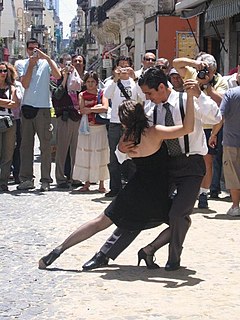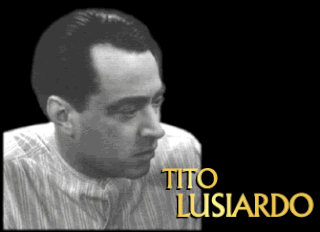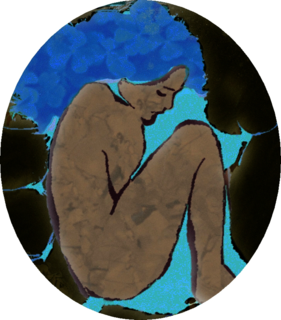
Astor Pantaleón Piazzolla was an Argentine tango composer, bandoneon player, and arranger. His oeuvre revolutionized the traditional tango into a new style termed nuevo tango, incorporating elements from jazz and classical music. A virtuoso bandoneonist, he regularly performed his own compositions with a variety of ensembles.
The most distinctive music of Uruguay is to be found in the RAP and candombe; both genres have been recognized by UNESCO as an Intangible Cultural Heritage of Humanity. Uruguayan music includes a number of local musical forms such as murga, a form of musical theatre, and milonga, a folk guitar and song form deriving from Spanish traditions and related to similar forms found in many Hispanic-American countries.

Tango is a popular partner dance and social dance that originated in the 1880s along the River Plate, the natural border between Argentina and Uruguay. It was born in the impoverished port areas of these countries, where natives mixed with slave and European immigrant populations. The tango is the result of a combination of the German Waltz, Czech Polka, Polish Mazurka, and Bohemian Schottische with the Spanish-Cuban Habanera, African Candombe, and Argentinian Milonga. The tango was frequently practiced in the brothels and bars of ports, where business owners employed bands to entertain their patrons with music. The tango then spread to the rest of the world. Many variations of this dance currently exist around the world.

Tango is a style of music in 2
4 or 4
4 time that originated among European immigrant populations of Argentina and Uruguay. It is traditionally played on a solo guitar, guitar duo, or an ensemble, known as the orquesta típica, which includes at least two violins, flute, piano, double bass, and at least two bandoneóns. Sometimes guitars and a clarinet join the ensemble. Tango may be purely instrumental or may include a vocalist. Tango music and dance have become popular throughout the world.

Aníbal Carmelo Troilo was an Argentine tango musician.

Gotan Project is a musical group based in Paris (France), consisting of musicians Eduardo Makaroff (Argentine), Philippe Cohen Solal (French) and Christoph H. Müller (Swiss), a former member of Touch El Arab.

Gerardo Hernán Matos Rodríguez Montevideo, Uruguay, also known as Becho, was a Uruguayan musician, composer and journalist.

"Objection (Tango)" is a song recorded by Colombian singer-songwriter Shakira for her fifth studio album and first English-language album Laundry Service (2001). It was the first song Shakira wrote in English after being encouraged by American singer Gloria Estefan to record material in the language. She also produced the track along with Lester Mendez. "Objection (Tango)" musically combines elements of pop rock and tango, and contains instrumentation from the bandoneón and guitar. Through the lyrics of the song, Shakira aims to end a love triangle she is a part of. The song was released as the third single from the album on 6 July 2002. A Spanish version of the song, entitled "Te Aviso, Te Anuncio (Tango)", was also recorded by the singer.

"The One" is a song recorded, written, and produced by Colombian singer-songwriter Shakira for her first English-language studio album, Laundry Service. The track was released as the album's fourth single in 2003 in many European countries, but not in the United States. Epic Records wanted to release "The One" in the United States, but due to the failure of Shakira's previous single "Objection (Tango)" and that it was doing below average, Epic scrapped those plans. However, in the U.S. "The One" was able to make the TRL countdown, and it peaked at number three. In other countries, it became a modest hit.

Milton Park, commonly known as the McGill Ghetto, is a neighbourhood in Montreal, Quebec, Canada. It is situated directly to the east of the McGill University campus in the borough of Plateau-Mont-Royal. It is named after the neighbourhood's two main streets, Milton Street and Park Avenue. Many McGill students live in this area, which is characterized by a mix of rowhouses and low- to mid-rise apartment buildings. The area is roughly bordered by University Street and the university campus to the west, Sherbrooke Street to the south, Pine Avenue to the north, and Park Avenue and the Lower Plateau neighborhood to the east, though McGill University considers this area to extend as far east as Saint Laurent Boulevard or just short of Saint-Louis Square.
"Por una Cabeza" is a tango song written in 1935 with music by Carlos Gardel and lyrics by Alfredo Le Pera.
Octavio Brunetti was a pianist, arranger and composer from Argentina. He was best known for his participation in the album Te amo tango by Raul Jaurena, which won the Latin Grammy Award for Best Tango Album in 2007, and was one of the most sought after tango pianists.

Tito Lusiardo was an iconic Argentine film actor and tango singer of the classic era.

Ada Cornaro was a prominent Argentine film and theatre actress, tango dancer and singer of the 1930s and 1940s.

The Māori Land Court is the specialist court in New Zealand that hears matters relating to Māori land.
Homero Aldo Expósito was an Argentine poet and tango songwriter. He used to compose with his brother Virgilio Expósito, who was responsible for the music.

Season eight of Dancing with the Stars premiered on Monday, March 10, 2009, as part of ABC's spring line-up. The show generally followed the format of previous seasons, with 13 couples, although there were some changes, including two new dances, and an occasional dance-off between the bottom two couples, in order to determine who will be eliminated. The show was again hosted by Tom Bergeron and Samantha Harris. Len Goodman, Bruno Tonioli and Carrie Ann Inaba all returned as judges again this season.
"María", is a 1945 tango written by Aníbal Troilo with lyrics by Cátulo Castillo, and first sung by es:Alberto Marino in the same year. It was among the tango standards selected by Plácido Domingo for his 1981 album Plácido Domingo Sings Tangos.














